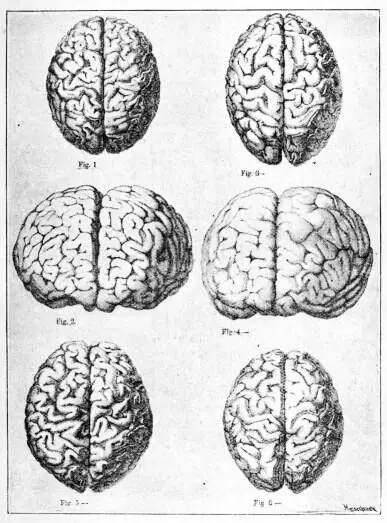Cesare Lombroso - The Man of Genius
Здесь есть возможность читать онлайн «Cesare Lombroso - The Man of Genius» — ознакомительный отрывок электронной книги совершенно бесплатно, а после прочтения отрывка купить полную версию. В некоторых случаях можно слушать аудио, скачать через торрент в формате fb2 и присутствует краткое содержание. Жанр: foreign_antique, foreign_prose, на английском языке. Описание произведения, (предисловие) а так же отзывы посетителей доступны на портале библиотеки ЛибКат.
- Название:The Man of Genius
- Автор:
- Жанр:
- Год:неизвестен
- ISBN:нет данных
- Рейтинг книги:5 / 5. Голосов: 1
-
Избранное:Добавить в избранное
- Отзывы:
-
Ваша оценка:
- 100
- 1
- 2
- 3
- 4
- 5
The Man of Genius: краткое содержание, описание и аннотация
Предлагаем к чтению аннотацию, описание, краткое содержание или предисловие (зависит от того, что написал сам автор книги «The Man of Genius»). Если вы не нашли необходимую информацию о книге — напишите в комментариях, мы постараемся отыскать её.
The Man of Genius — читать онлайн ознакомительный отрывок
Ниже представлен текст книги, разбитый по страницам. Система сохранения места последней прочитанной страницы, позволяет с удобством читать онлайн бесплатно книгу «The Man of Genius», без необходимости каждый раз заново искать на чём Вы остановились. Поставьте закладку, и сможете в любой момент перейти на страницу, на которой закончили чтение.
Интервал:
Закладка:
The researches of other investigators have shown that Manzoni, Petrarch, and Fusinieri had receding foreheads; in Byron, Massacra (at the age of 32), Humboldt, Meckel, 25 25 Welcker, Schiller’s Schädel , 1883.
Foscolo, Ximenes, and Donizetti there was solidification of the sutures; submicrocephaly in Rasori, Descartes, Foscolo, Tissot, Guido Reni, Hoffmann, and Schumann; sclerosis in Donizetti and Tiedemann who, moreover, presented a bony crest between the sphenoid and the basilar apophysis; hydrocephalus in Milton, Linnæus, Cuvier, Gibbon, &c.
The capacity of the skull in men of genius, as is natural, is above the average, by which it approaches what is found in insanity. (De Quatrefages noted that the greatest degree of macrocephaly was found in a lunatic, the next in a man of genius.) There are numerous exceptions in which it descends below the ordinary average.
It is certain that in Italy, Volta (1,860 c.cm.), Petrarch (1,602 c.cm.), Bordoni (1,681 c.cm.), Brunacci (1,701 c.cm.), St. Ambrose (1,792 c.cm.), and Fusinieri (1,604 c.cm.), all presented great cranial capacity. The same character is found to a still greater degree in Kant (1,740 c.cm.), Thackeray (1,660 c.cm.), Cuvier (1,830 c.cm.), and Tourgueneff (2,012 c.cm.).
Le Bon studied twenty-six skulls of French men of genius, among whom were Boileau, Descartes, and Jourdan. 26 26 Revue Scientifique , 1882.
He found that the most celebrated had an average capacity of 1,732 cubic centimetres; while the ancient Parisians offered only 1,559 c.cm. Among the Parisians of to-day scarcely 12 per cent. exceed 1,700 c.cm., a figure surpassed by 73 per cent. of the celebrated men.
But sub-microcephalic skulls may also be found in men of genius. Wagner and Bischoff, 27 27 Wagner ( Das Hirngewicht , 1877) gives these measurements of scientific men of Gottingen: — Bischoff ( Hirngewichte bei Münchener Gelehrten ) gives the following measurements: — The measurement of the cerebral area often gives superiority even to those men of genius who present a feeble weight. Fuchs had a cerebral surface of 22,1005 square c. and Gauss of 21,9588; while with the same weight the same surface in an unknown woman was 20,4115 and in a workman 18,7672.
examining twelve brains of celebrated Germans, found the capacity very great in eight, very small in four. The latter was the case with Liebig, Döllinger, Hausmann, in whose favour advanced age may be advanced as an excuse; but this reason does not exist for Guido Reni, Gambetta, Harless, Foscolo (1426), Dante (1493), Hermann (1358), Lasker (1300). Shelley’s head was remarkably small.
In the face of all these facts I shall not be taxed with temerity if I conclude that, as genius is often expiated by inferiority in some psychic functions, it is often associated with anomalies in that organ which is the source of its glory.
Reference should here be made to the ventricular dropsy in Rousseau’s brain, 28 28 Bulletin de la Société d’Anthropologie , 1861.
to the meningitis of Grossi, of Donizetti, and of Schumann, to the cerebral œdema of Liebig and of Tiedemann. In the last-named, besides remarkable thickness of the skull, especially at the forehead, Bischoff noted adherence of the dura mater to the bone, thickening of the arachnoid and atrophy of the brain. In the physician Fuchs, Wagner found the fissure of Rolando interrupted by a superficial convolution, an anomaly which Giacomini found only once in 356 cases, and Heschl once in 632. 29 29 Die tiefen Windungen des Menschenhirnes , 1877.
Pascal’s brain showed grave lesions of the cerebral hemispheres. It has recently been discovered that Cuvier’s voluminous brain was affected by dropsy; in Lasker’s there was softening of the corpora striata, pachymeningitis, hæmorrhage, and endarteritis deformans of the artery of the fissure of Sylvius. 30 30 Mendel, Centralblatt , No. 4, 1884.
In eighteen brains of German men of science Bischoff and Rüdinger found congenital anomalies of the cerebral convolutions, especially of the parietal. 31 31 Ein Beitrag zur Anatomie der Affenspalte und der Interparietal Furche beim Menschen nach Rasse, Geschlecht, und Individualität , 1886.
In the brains of Wülfert and Huber, the third left frontal convolution was greatly developed with numerous meanderings. In Gambetta this exaggeration became a real doubling; and the right quadrilateral lobule is divided into two parts by a furrow which starts from the occipital fissure; of these two parts the inferior is subdivided by an incision with numerous branches, arranged in the form of stars, and the occipital lobe is small, especially on the right. 32 32 Bulletin de la Société d’Anthropologie , 1886, p. 135.
“The comparative study of these brains,” writes Hervé, 33 33 La Circonvolution de Broca , Paris, 1888.
“shows that individual variations of the cerebral convolutions are more numerous and more marked in men of genius than in others. This is especially the case in regard to the third frontal convolution which is not only more variable in men of genius, but also more complex, especially on one side, while in ordinary persons it is very simple both on the left and on the right. Without doubt the individual arrangements which may be presented by the brains of men of remarkable intelligence may also be found in ordinary brains, but only in rare exceptions.”
I refer those who wish to form an idea of the development reached by Broca’s centre in some of the brains of the Munich collection to Rüdinger’s monograph, and to the beautiful plates which accompany it. One remarks especially the enormous size and the numerous superficial folds at the foot of the left convolution in the jurist Wülfert, who was remarkable among other qualities for his great oratorical talent. On the other hand, the convolution is much reduced and very simple on the left, much developed in all its parts on the right, in the brain of the pathologist Buhl, a professor whose speech was clear and facile, but who was left-handed, or at all events ambidextrous. To these facts others may be added, showing the morphological complexity of Broca’s convolution in distinguished men; in the brains, for instance, of various men of science, described and figured by R. Wagner. 34 34 Vorstudien, &c. , 1st Memoir, 1860.
Among these was the illustrious geometrician, Gauss: compared with Gauss’s brain that of an artisan called

Fig. 1. Gauss’s Brain.
“ 2. Frontal Lobe of same.
“ 3. Brain of a German Workman.
Fig. 4. Frontal Lobe of same.
“ 5. Dirichlet’s Brain.
“ 6. Hermann’s Brain.
Krebs was much less complicated, and notably narrower in the frontal region. The frontal convolutions were also inferior in development to those of Gauss; and the anterior lobes were voluminous in another celebrated mathematician, Professor De Morgan, whose brain is in Bastian’s possession. 35 35 Le Cerveau et la Pensée , t. ii. p. 46.
Stammering. – Men of genius frequently stammer. I will mention: Aristotle, Æsop, Demosthenes, Alcibiades, Cato of Utica, Virgil, Manzoni, Erasmus, Malherbe, C. Lamb, Turenne, Erasmus and Charles Darwin, Moses Mendelssohn, Charles V., Romiti, Cardan, Tartaglia.
Lefthandedness. – Many have been left-handed. Such were: Tiberius, Sebastian del Piombo, Michelangelo, Fléchier, Nigra, Buhl, Raphael of Montelupo, Bertillon. Leonardo da Vinci sketched rapidly with his left hand any figures which struck him, and only employed the right hand for those which were the mature result of his contemplation; for this reason his friends were persuaded that he only wrote with the left hand. 36 36 Gallichon in Gazette des Beaux Arts , 1867.
Mancinism or leftsidedness is to-day regarded as a character of atavism and degeneration. 37 37 Lombroso, Sul Mancinismo motorio e sensorio nei sani e negli alienati , 1885, Turin.
Интервал:
Закладка:
Похожие книги на «The Man of Genius»
Представляем Вашему вниманию похожие книги на «The Man of Genius» списком для выбора. Мы отобрали схожую по названию и смыслу литературу в надежде предоставить читателям больше вариантов отыскать новые, интересные, ещё непрочитанные произведения.
Обсуждение, отзывы о книге «The Man of Genius» и просто собственные мнения читателей. Оставьте ваши комментарии, напишите, что Вы думаете о произведении, его смысле или главных героях. Укажите что конкретно понравилось, а что нет, и почему Вы так считаете.












